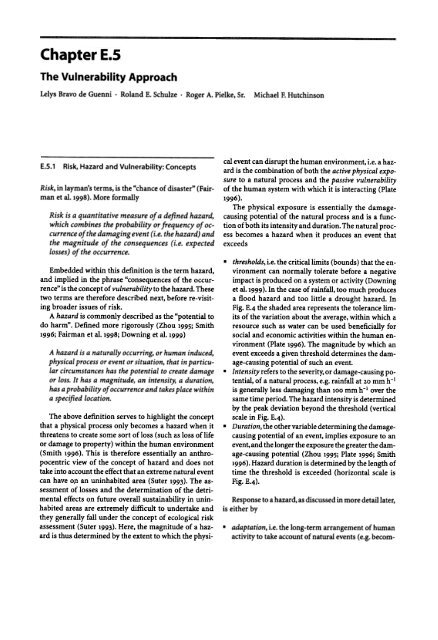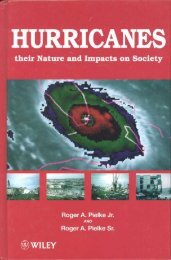How to evaluate vulnerability in changing environmental conditions
How to evaluate vulnerability in changing environmental conditions
How to evaluate vulnerability in changing environmental conditions
Create successful ePaper yourself
Turn your PDF publications into a flip-book with our unique Google optimized e-Paper software.
The Vulnerability Approach<br />
Lelys Bravo de Guenni .Roland E. Schulze. Roger A. Pielke, Sr. Michael F. Hutch<strong>in</strong>son<br />
E.5.1 Risk, Hazard and Vulnerability: Concepts<br />
Risk, <strong>in</strong> layman's terms, is the "chance of disaster" (Fairman<br />
et aI. 1998). More formally<br />
Risk is a quantitative measure of a def<strong>in</strong>ed hazard,<br />
which comb<strong>in</strong>es the probability or frequency of occurrence<br />
of the damag<strong>in</strong>g event (i.e. the hazard) and<br />
the magnitude of the consequences (i.e. expected<br />
losses) of the occurrence.<br />
Embedded with<strong>in</strong> this defmition is the term hazard,<br />
and implied <strong>in</strong> the phrase "consequences of the occurrence"<br />
is the concept of <strong>vulnerability</strong> <strong>to</strong> the hazard. These<br />
two terms are therefore described next, before re-visit<strong>in</strong>g<br />
broader issues of risk.<br />
A hazard is commonly described as the "potential <strong>to</strong><br />
do harm". Def<strong>in</strong>ed more rigorously (Zhou 1995; Smith<br />
1996; Fairman et al.1998; Down<strong>in</strong>g et al.1999)<br />
A hazard is a naturally occurr<strong>in</strong>g, or human <strong>in</strong>duced,<br />
physical process or event or situation, that <strong>in</strong> particular<br />
circumstances has the potential <strong>to</strong> create damage<br />
or loss. It has a magnitude, an <strong>in</strong>tensity, a duration,<br />
has a probability of occurrence and takes place with<strong>in</strong><br />
a specified location.<br />
The above def<strong>in</strong>ition serves <strong>to</strong> highlight the concept<br />
that a physical process only becomes a hazard when it<br />
threatens <strong>to</strong> create some sort of loss (such as loss of life<br />
or damage <strong>to</strong> property) with<strong>in</strong> the human environment<br />
(Smith 1996). This is therefore essentially an anthropocentric<br />
view of the concept of hazard and does not<br />
take <strong>in</strong><strong>to</strong> account the effect that an extreme natural event<br />
can have op an un<strong>in</strong>habited area (Suter 1993). The assessment<br />
of losses and the determ<strong>in</strong>ation of the detrimental<br />
effects on future overall susta<strong>in</strong> ability <strong>in</strong> un<strong>in</strong>habited<br />
areas are extremely difficult <strong>to</strong> undertake and<br />
they generally fall under the concept of ecological risk<br />
assessment (Suter 1993). Here, the magnitude of a hazard<br />
is thus determ<strong>in</strong>ed by the extent <strong>to</strong> which the physi-<br />
cal event can disrupt the human environment, i.e. a hazard<br />
is the comb<strong>in</strong>ation of both the active physical exposure<br />
<strong>to</strong> a natural process and the passive <strong>vulnerability</strong><br />
of the human system with which it is <strong>in</strong>teract<strong>in</strong>g (Plate<br />
1996).<br />
The physical exposure is essentially the damagecaus<strong>in</strong>g<br />
potential of the natural process and is a function<br />
of both its <strong>in</strong>tensity and duration. The natural process<br />
becomes a hazard when it produces an event that<br />
exceeds<br />
.thresholds, i.e. the critical limits (bounds) that the environment<br />
can normally <strong>to</strong>lerate before a negative<br />
impact is produced on a system or activity (Down<strong>in</strong>g<br />
et al. 1999). In the case of ra<strong>in</strong>fall, <strong>to</strong>o much produces<br />
a flood hazard and <strong>to</strong>o little a drought hazard. In<br />
Fig. E.4 the shaded area represents the <strong>to</strong>lerance limits<br />
of the variation about the average, with<strong>in</strong> which a<br />
resource such as water can be used beneficially for<br />
social and economic activities with<strong>in</strong> the human environment<br />
(Plate 1996). The magnitude by which an<br />
event exceeds a given threshold determ<strong>in</strong>es the damage-caus<strong>in</strong>g<br />
potential of such an event.<br />
.Intensity refers <strong>to</strong> the severity, or damage-caus<strong>in</strong>g potential,<br />
of a natural process, e.g. ra<strong>in</strong>fall at 20 mm h-l<br />
is generally less damag<strong>in</strong>g than 100 mm h-l over the<br />
same time period. The hazard <strong>in</strong>tensity is determ<strong>in</strong>ed<br />
by the peak deviation beyond the threshold (vertical<br />
scale <strong>in</strong> Fig. E.4).<br />
.Duration, the other variable determ<strong>in</strong><strong>in</strong>g the damagecaus<strong>in</strong>g<br />
potential of an event, implies exposure <strong>to</strong> an<br />
event, and the longer the exposure the greater the damage-caus<strong>in</strong>g<br />
potential (Zhou 1995; Plate 1996; Smith<br />
1996). Hazard duration is determ<strong>in</strong>ed by the length of<br />
time the threshold is exceeded (horizontal scale is<br />
Fig. E.4).<br />
Response <strong>to</strong> a hazard, as discussed <strong>in</strong> more detail later,<br />
is either by<br />
.adaptation, i.e. the long-term arrangement of human<br />
activity <strong>to</strong> take account of natural events (e.g. becom-














